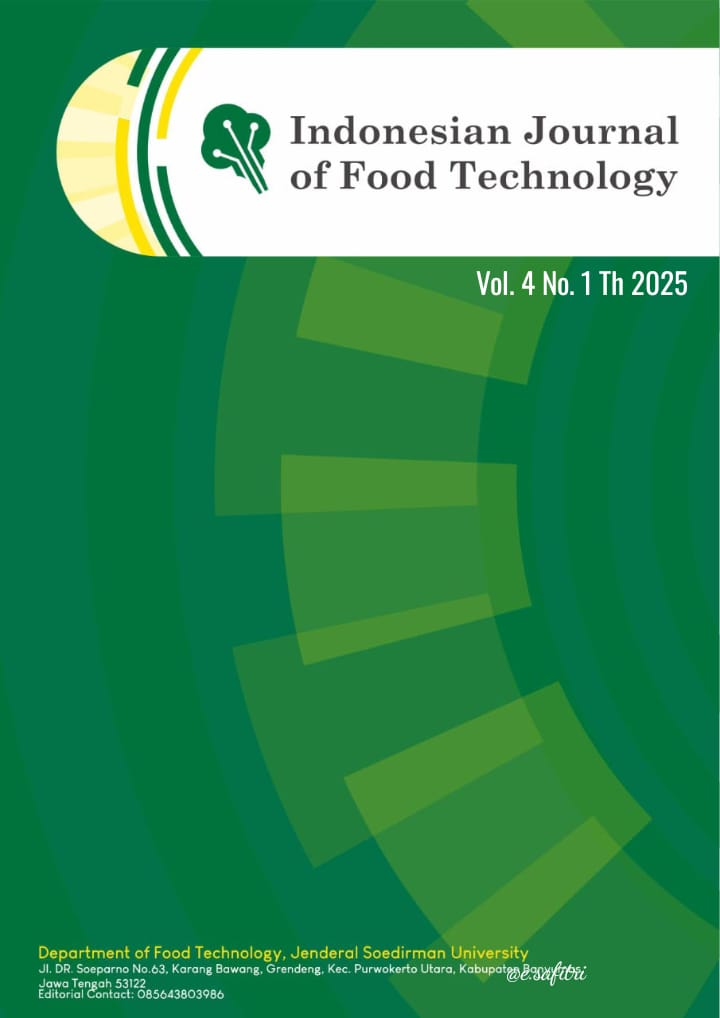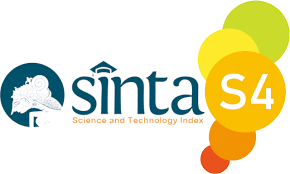Application of Ultrasonic Waves on Decaffeination Process of Gayo Aceh Arabica Coffee
Abstract
Gayo Aceh Arabica coffee is famous for its quality and unique taste. However, caffeine-sensitive consumers often stay away from this coffee because excessive caffeine intake can have a detrimental effect on health. Therefore, the decaffeination process is important in producing low-caffeine coffee without reducing its distinctive taste and aroma. The research focused on assessing the influence of ultrasonic waves on the decaffeination process of Aceh Gayo arabica coffee. This study employed an experimental method that included 6 treatments (extraction time): K1 (2 minutes), K2 (4 minutes), K3 (6 minutes), K4 (8 minutes), K5 (10 minutes), and K6 (12 minutes). The variables measured in this study included caffeine regain, chlorogenic acid levels, and organoleptic test results. The collected data was analyzed using (SPSS) software version 30. This study found the best results in treatment K4 (8 minutes), which showed caffeine recovery of 56.83%, chlorogenic acid content of 12.3%, and neutral sensory evaluation (4) for color, acidity, and aroma according to panelists.
References
Ahmad, I., Syakfanaya, A. M., Azminah, Saputri, F. C., Mun’im A. (2021). Optimization of betaine-sorbitol natural deep eutectic solvent-based ultrasound-assisted extraction and pancreatic lipase inhibitory activity of chlorogenic acid and caffeine content from robusta green coffee beans. Heliyon. 7.
Amaliah, A., Sobari E., Mukminah, N. (2018). Rendemen dan karakteristik fisik ekstrak oleoresin daun sirih hijau (Piper betle L.) dengan pelarut heksan. Industrial Research Workshop and National Seminar.
Anam, K., Sirappa, M. P., Sangkala, Nurwahyuningsih, Meilin, A., Handayani, A. B. M. H.T., Irawan, N. C., Masrika, N. U. E. (2019). Budidaya tanaman kopi dan olahannya untuk kesehatan. CV. Tohar Media. Makassar. Hal 1-55.
Ardiansyah, D., Tjota, H., & Kiyat, W. E. (2018). Review: Peran enzim dalam meningkatkan kualitas kopi. JURNAL AGRI-TEK : Jurnal Penelitian Ilmu-Ilmu Eksakta, 19(2). https://doi.org/10.33319/agtek.v19i2.25
Awwad, S., Issa, R., Alnsour, L., Albals, D., & Al-Momani, I. (2021). Quantification of caffeine and chlorogenic acid in green and roasted coffee samples using hplc-dad and evaluation of the effect of degree of roasting on their levels. Molecules, 26(24). https://doi.org/10.3390/molecules26247502
Azizah, N. D. N., Novita, C. R. L., Sihombing, R. P., & Hariyadi, T. (2022). Penentuan suhu optimum dekafeinasi kopi arabika Sigarar Utang menggunakan pelarut asam asetat. Prosiding The 13th Industrial Research Workshop and National Seminar, Bandung, 13–14 Juli.
Chemat, F., Rombaut, N., Sicaire, A. G., Meullemiestre, A., Fabiano-Tixier, A. S., & Abert-Vian, M. (2017). Ultrasound assisted extraction of food and natural products. Mechanisms, techniques, combinations, protocols and applications. A review. Ultrasonics Sonochemistry, 34, 540–560. https://doi.org/10.1016/j.ultsonch.2016.06.035.
Direktorat Jenderal Perkebunan. (2022). Pengembangan kopi secara berkelanjutan “Upaya perbaikan kontaminasi pestisida pada perkebunan kopi. Kementrian Pertanian Direktorat Jendral Perkebunan. Jakarta.
Elfariyanti, Silviana, E., & Santika, M. (2020). Analisis kandungan kafein pada kopi seduhan warung kopi di kota Banda Aceh. Lantanida Journal, 8(1):1-95.
Farhaty, N., dan Muchtaridi, M. (2016). Tinjauan kimia dan aspek farmakologi senyawa asam klorogenat pada biji kopi. Jurnal Farmaka, 14(1), 214-227.
Harris, D. C. (2015). Quantitative chemical analysis. W. H. Freeman and Company. New York. Hal 55-57.
Ismail, S., Nurrahmah, dan Ahmad, M. Y. (2022). Kopi Gayo: kajian historis dan sosiologis. Dinas Perpustakaan dan Kearsipan Aceh. Banda Aceh. Hal. 5-74.
Iswandi. (2022). Pengaruh perendaman terhadap kadar kafein pada biji kopi di kota Surakarta secara spektrofotometri Uv-Vis. Pharmacon, 11(2).
Kusnadi, J., Andayani, D. W., Zubaidah, E., & Arumingtyas, E. L. (2019). Ekstraksi senyawa bioaktif cabai rawit (Capsicum Frutescens L.) Menggunakan metode ekstraksi gelombang ultrasonik. Jurnal Teknologi Pertanian, 20(2), 79-84.
Kusriningrum, R. S. (2008). Perancangan Percobaan. Surabaya Airlangga University Press. Surabaya. Hal 96-118.
Latunra, A. I., Johannes, E., Mulihardianti, B., & Sumule, O. (2021). Analisis kandungan kafein kopi (Coffea Arabica) pada tingkat kematangan berbeda menggunakan spektrofotometer Uv-Vis. Jurnal Ilmu Alam dan Lingkungan, 12(1), 45-50.
Lee, J. S., Kim, M. S., Shin, H. J., and Park, K.H. (2015). Analysis of off-flavor compounds from over-extraction coffee. Korean journal of food science and technology, 43(3), 348-360.
Lolongan, R., & Yacob, N. (2021). Dekafeinasi kopi robusta menggunakan proses ekstraksi. SAINTIS, 2(1).
Mardiana, R., Shidiq, S. S., Widiastuti, E., Hariyadi, T. (2021). Pengaruh suhu roasting terhadap perubahan kadar lemak, kadar asam total, dan morfologi mikrostruktural kopi robusta. Prosiding The 12th Industrial Research Workshop and National Seminar, Bandung, 4-5 agustus 2021.
Meng, Y., Sui, X., Pan, X., Yang, Y., Sui, H., Xu, T., Zhang, H., Liu, T., Liu, J., & Ge, P. (2023). An integrated process by ultrasonic enhancement in the deep eutectic solvents system for extraction and separation of chlorogenic acid from Eucommia ulmoides leaves. Ultrasonics Sonochemistry, 99.
Muqorrobin, M., & Mustikaningrum, M. (2023). Pengaruh Perbedaan Suhu dan Waktu Terhadap Kinetika Ekstraksi Minyak dengan Metode Ultrasonik pada Ampas Kopi. Jurnal Integrasi Proses dan Lingkungan. 1(1).
Perdana, R. (2024). Analisis kandungan minyak nabati menggunakan metode ekstraksi kontinyu. Jurnal Riset Sains dan Kesehatan Indonesia. 1(2). https://journal.scitechgrup.com/index.php/jrski64.
Pradana, F. A., Khoirul, D. M., & Septian, A. (2017). The Effectiveness Test of Ultrasonic Extraction Microwave Distillation (USE-MD) Method in Capsaicin Extraction. Journal of Engineering, 3(1), 6-10.
Standar Nasional Indonesia. (2008). Biji kopi. Badan Standarisasi Nasional. Jakarta.
Sundari, D., Darwin, dan Ratna. (2020). Fermentasi kopi arabika (Coffea arabica) menggunakan inokulum feses luwak. Jurnal Ilmiah Mahasiswa Pertanian. 5(1).
Utama, D. Q., Paramartha, D. N. A., Widyasari, R., & Nurul, A. (2022). Dekafeinasi kopi robusta (Coffea Canephora) lombok menggunakan sari labu siam (Sechium Edule). Pro Food, 8(1). http://www.profood.unram.ac.id/index.php/profood.
Wahyuningsih, S., Yunita, I., Sundari, U. Y., Suryandani, H., Pagalla, D. B., Kalalinggi, S. Y., Alpian., Ramlah, Nasrullah, M. (2024). Ekstraksi bahan alam. CV. Gita Lentera Redaksi. Sumatera Barat. Hal. 1-126.
Wijaya, A. D., & Yuwono, S. S. (2015). Pengaruh lama pengukusan dan konsentrasi etil asetat terhadap karakteristik kopi pada proses dekafeinasi kopi. Jurnal Pangan dan Agroindustri, 3(4).
Wijaya, H., Jubaidah, S., Rukayyah. (2022). Perbandingan metode ekstraksi maserasi dan sokhletasi terhadap rendemen ekstrak batang turi (Sesbania Grandiflora L.). Indonesia Journal of Pharmacy and Natural Product, 5(01).
Yusuf, Y. K., Permatasari, D. A. I., Veranita, W. (2022). Pengaruh waktu ekstraksi pada kadar kafein produk biji kopi arabica dari kabupaten tegal dengan metode spektrofotometri Uv-Vis. Duta Pharma Journal. 2(1).











